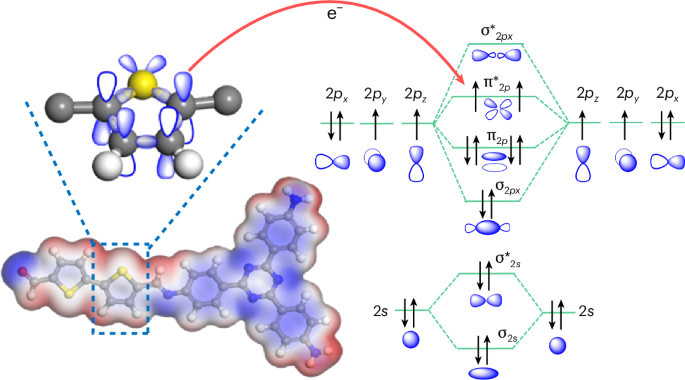Enhanced hydrogen peroxide photosynthesis in covalent organic frameworks through induced asymmetric electron distribution
IF 20
0 CHEMISTRY, MULTIDISCIPLINARY
引用次数: 0
Abstract
Covalent organic frameworks (COFs) can be used as photocatalysts for the direct photosynthesis of hydrogen peroxide (H2O2) from oxygen, water and sunlight. However, their highly symmetric structure can lead to weak adsorption of O2 and, therefore, unsatisfactory photocatalytic performance. Here we explore the local asymmetric electron distribution induced by Pauli and electron–electron repulsion in COFs to construct localized bonding sites for O2 species, which promotes photocatalytic H2O2 production. Experimental results and theoretical calculations reveal that TAPT–FTPB COFs (where TAPT is 1,3,5-tris-(4-aminophenyl) triazine and FTPB is 5-(5-formylthiophen-2-yl)thiophene-2-carbaldehyde) with an asymmetric electron distribution show strong O2 adsorption interaction and a record-breaking solar-to-chemical conversion efficiency of 1.22% for direct photosynthesis of H2O2 from oxygen and water, which is higher than in the photosynthesis of plants (~0.1%). A flow-type photocatalytic microreactor integrated with TAPT–FTPB COFs exhibits 100% sterilization efficiency for killing bacteria and 97.8% conversion for photocatalytic 2-thiophene methylamine coupling. This work reports a strategy for manipulating the local electron distribution in COFs, opening the door for research on the rational design of high-performance photocatalysis with a local asymmetric electron distribution. Covalent organic frameworks (COFs) are promising photocatalysts for the direct photosynthesis of H2O2, but their symmetric structure can lead to weak O2 adsorption. Now thiophene sulfur atoms are introduced into COFs to induce local asymmetric electron distributions, which enhance the O2 adsorption capacity and interaction of the COFs, promoting direct photosynthesis of H2O2.


通过诱导不对称电子分布增强共价有机框架中的过氧化氢光合作用
共价有机框架(COFs)可用作光催化剂,直接利用氧气、水和阳光进行过氧化氢(H2O2)的光合作用。然而,它们的高度对称结构会导致对 O2 的吸附能力较弱,因此光催化性能不尽人意。在此,我们探讨了 COFs 中保利和电子-电子斥力诱导的局部不对称电子分布,从而为 O2 物种构建局部键合位点,促进光催化 H2O2 的产生。实验结果和理论计算显示,具有非对称电子分布的 TAPT-FTPB COFs(其中 TAPT 为 1,3,5- 三-(4-氨基苯基)三嗪,FTPB 为 5-(5-醛基噻吩-2-基)噻吩-2-甲醛)显示出很强的 O2 吸附相互作用,其太阳能-化学转化效率达到破纪录的 1.22% ,高于植物光合作用(约 0.1%)。集成了 TAPT-FTPB COFs 的流动型光催化微反应器在杀灭细菌方面的灭菌效率为 100%,在光催化 2-噻吩甲胺偶联方面的转化率为 97.8%。这项工作报告了一种操纵 COFs 中局部电子分布的策略,为合理设计具有局部不对称电子分布的高性能光催化技术的研究打开了大门。
本文章由计算机程序翻译,如有差异,请以英文原文为准。
求助全文
约1分钟内获得全文
求助全文

 求助内容:
求助内容: 应助结果提醒方式:
应助结果提醒方式:


